BM414 Financial Decision Making: Financial Roles & Panini Ltd Analysis
VerifiedAdded on 2023/06/10
|12
|3128
|186
Report
AI Summary
This report examines the accounting and finance functions within a business enterprise, highlighting their roles and duties in efficient fund utilization and decision-making. It explores various funding sources available to small and medium-sized enterprises for expansion. The report includes an analysis of Panini Ltd's financial performance for the years 2018 and 2019, computing key ratios related to profitability, solvency, and efficiency. The analysis covers operating profit margin, gross profit margin, current ratio, inventory turnover days, creditor's collection period, quick ratio, debtor's collection period, and return on capital employed to assess the company's financial health and performance over the two-year period.

INDIVIDUAL
WRITING
WRITING
Paraphrase This Document
Need a fresh take? Get an instant paraphrase of this document with our AI Paraphraser
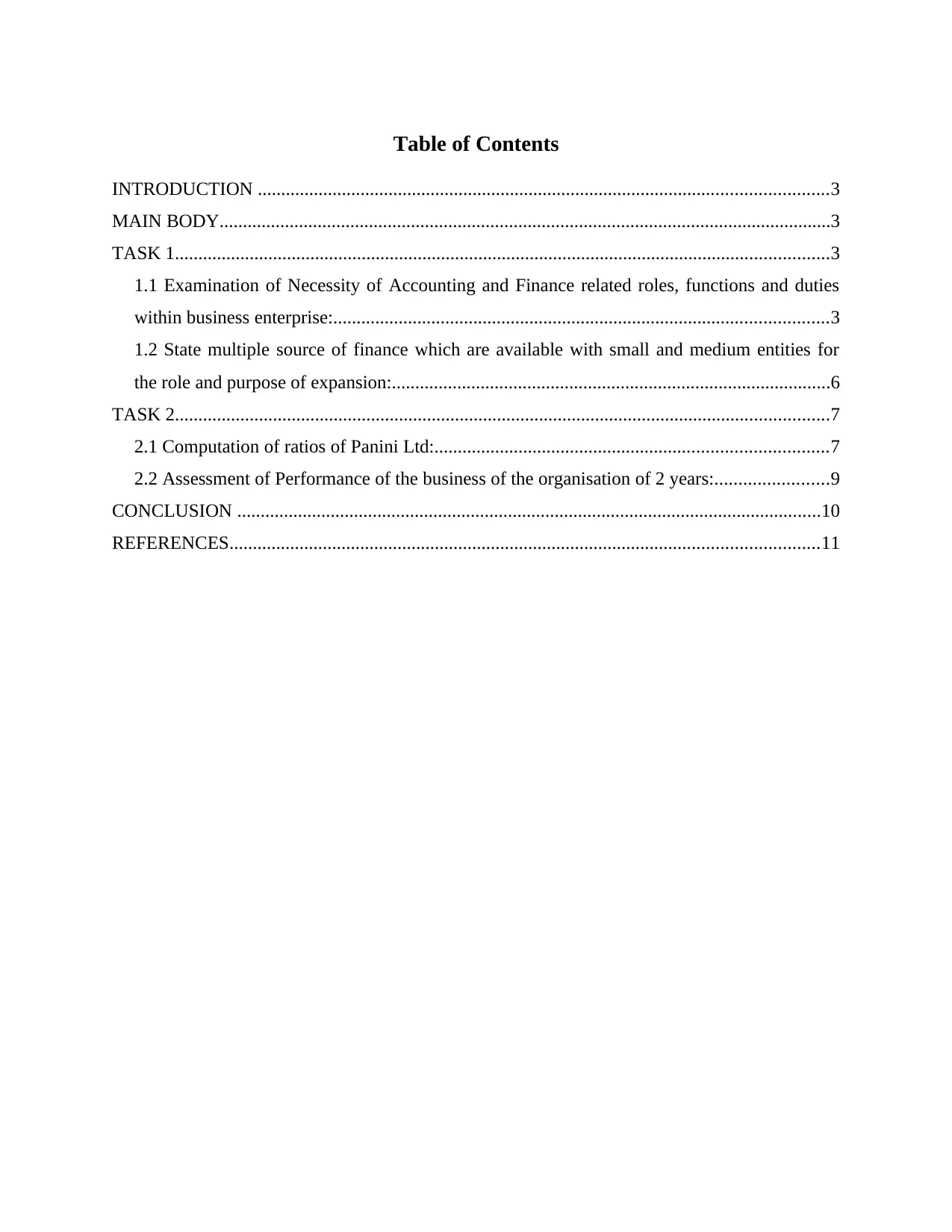
Table of Contents
INTRODUCTION ..........................................................................................................................3
MAIN BODY...................................................................................................................................3
TASK 1............................................................................................................................................3
1.1 Examination of Necessity of Accounting and Finance related roles, functions and duties
within business enterprise:..........................................................................................................3
1.2 State multiple source of finance which are available with small and medium entities for
the role and purpose of expansion:..............................................................................................6
TASK 2............................................................................................................................................7
2.1 Computation of ratios of Panini Ltd:....................................................................................7
2.2 Assessment of Performance of the business of the organisation of 2 years:........................9
CONCLUSION .............................................................................................................................10
REFERENCES..............................................................................................................................11
INTRODUCTION ..........................................................................................................................3
MAIN BODY...................................................................................................................................3
TASK 1............................................................................................................................................3
1.1 Examination of Necessity of Accounting and Finance related roles, functions and duties
within business enterprise:..........................................................................................................3
1.2 State multiple source of finance which are available with small and medium entities for
the role and purpose of expansion:..............................................................................................6
TASK 2............................................................................................................................................7
2.1 Computation of ratios of Panini Ltd:....................................................................................7
2.2 Assessment of Performance of the business of the organisation of 2 years:........................9
CONCLUSION .............................................................................................................................10
REFERENCES..............................................................................................................................11
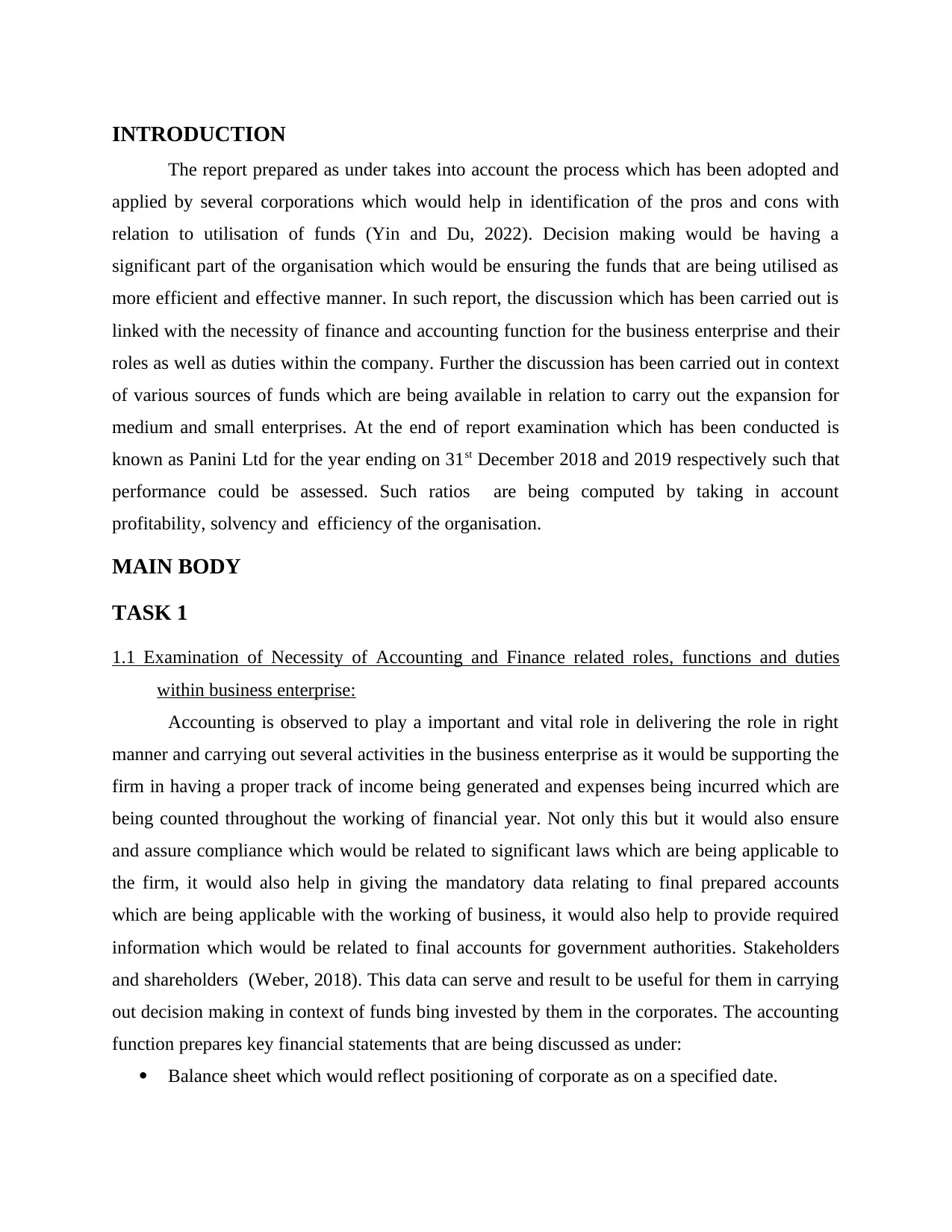
INTRODUCTION
The report prepared as under takes into account the process which has been adopted and
applied by several corporations which would help in identification of the pros and cons with
relation to utilisation of funds (Yin and Du, 2022). Decision making would be having a
significant part of the organisation which would be ensuring the funds that are being utilised as
more efficient and effective manner. In such report, the discussion which has been carried out is
linked with the necessity of finance and accounting function for the business enterprise and their
roles as well as duties within the company. Further the discussion has been carried out in context
of various sources of funds which are being available in relation to carry out the expansion for
medium and small enterprises. At the end of report examination which has been conducted is
known as Panini Ltd for the year ending on 31st December 2018 and 2019 respectively such that
performance could be assessed. Such ratios are being computed by taking in account
profitability, solvency and efficiency of the organisation.
MAIN BODY
TASK 1
1.1 Examination of Necessity of Accounting and Finance related roles, functions and duties
within business enterprise:
Accounting is observed to play a important and vital role in delivering the role in right
manner and carrying out several activities in the business enterprise as it would be supporting the
firm in having a proper track of income being generated and expenses being incurred which are
being counted throughout the working of financial year. Not only this but it would also ensure
and assure compliance which would be related to significant laws which are being applicable to
the firm, it would also help in giving the mandatory data relating to final prepared accounts
which are being applicable with the working of business, it would also help to provide required
information which would be related to final accounts for government authorities. Stakeholders
and shareholders (Weber, 2018). This data can serve and result to be useful for them in carrying
out decision making in context of funds bing invested by them in the corporates. The accounting
function prepares key financial statements that are being discussed as under:
Balance sheet which would reflect positioning of corporate as on a specified date.
The report prepared as under takes into account the process which has been adopted and
applied by several corporations which would help in identification of the pros and cons with
relation to utilisation of funds (Yin and Du, 2022). Decision making would be having a
significant part of the organisation which would be ensuring the funds that are being utilised as
more efficient and effective manner. In such report, the discussion which has been carried out is
linked with the necessity of finance and accounting function for the business enterprise and their
roles as well as duties within the company. Further the discussion has been carried out in context
of various sources of funds which are being available in relation to carry out the expansion for
medium and small enterprises. At the end of report examination which has been conducted is
known as Panini Ltd for the year ending on 31st December 2018 and 2019 respectively such that
performance could be assessed. Such ratios are being computed by taking in account
profitability, solvency and efficiency of the organisation.
MAIN BODY
TASK 1
1.1 Examination of Necessity of Accounting and Finance related roles, functions and duties
within business enterprise:
Accounting is observed to play a important and vital role in delivering the role in right
manner and carrying out several activities in the business enterprise as it would be supporting the
firm in having a proper track of income being generated and expenses being incurred which are
being counted throughout the working of financial year. Not only this but it would also ensure
and assure compliance which would be related to significant laws which are being applicable to
the firm, it would also help in giving the mandatory data relating to final prepared accounts
which are being applicable with the working of business, it would also help to provide required
information which would be related to final accounts for government authorities. Stakeholders
and shareholders (Weber, 2018). This data can serve and result to be useful for them in carrying
out decision making in context of funds bing invested by them in the corporates. The accounting
function prepares key financial statements that are being discussed as under:
Balance sheet which would reflect positioning of corporate as on a specified date.
⊘ This is a preview!⊘
Do you want full access?
Subscribe today to unlock all pages.

Trusted by 1+ million students worldwide
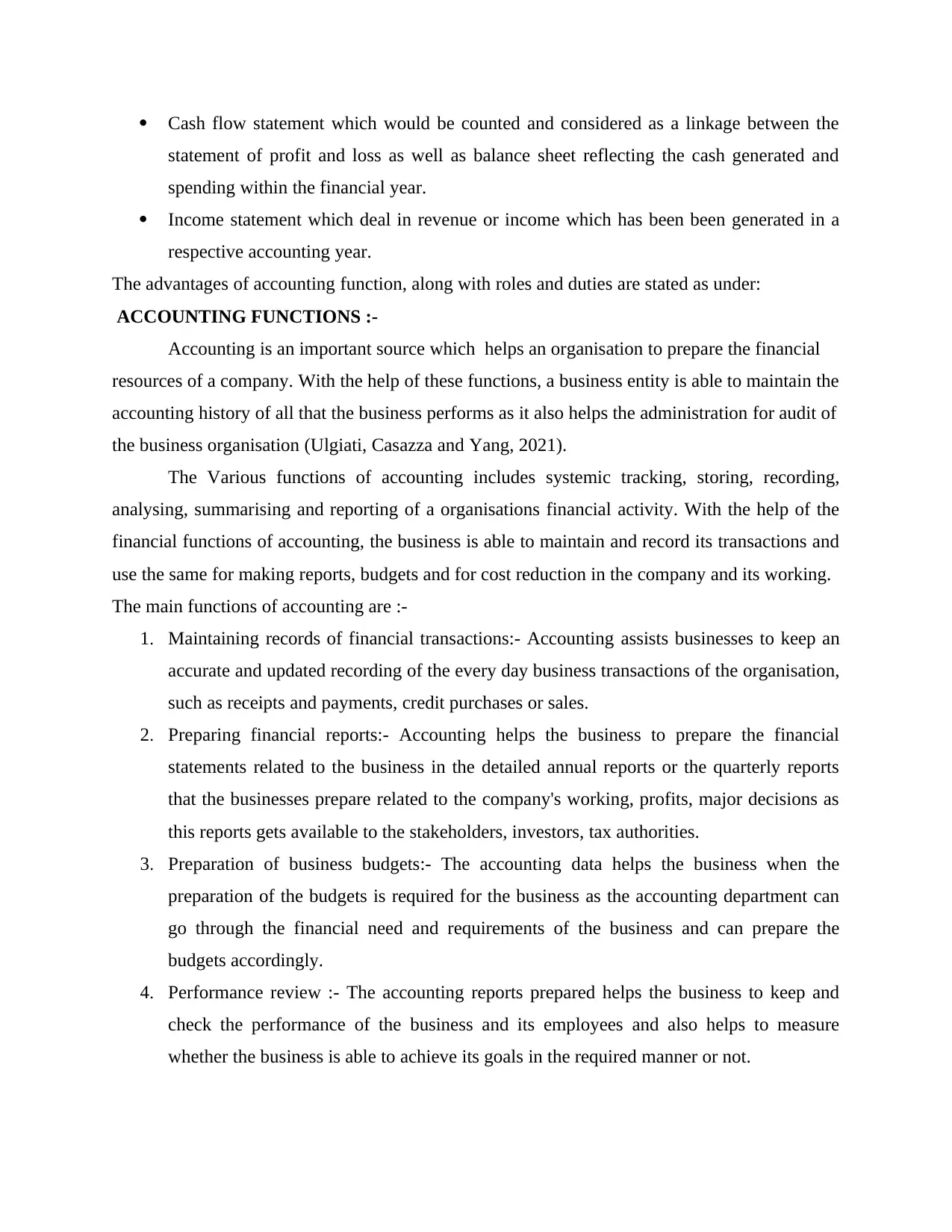
Cash flow statement which would be counted and considered as a linkage between the
statement of profit and loss as well as balance sheet reflecting the cash generated and
spending within the financial year.
Income statement which deal in revenue or income which has been been generated in a
respective accounting year.
The advantages of accounting function, along with roles and duties are stated as under:
ACCOUNTING FUNCTIONS :-
Accounting is an important source which helps an organisation to prepare the financial
resources of a company. With the help of these functions, a business entity is able to maintain the
accounting history of all that the business performs as it also helps the administration for audit of
the business organisation (Ulgiati, Casazza and Yang, 2021).
The Various functions of accounting includes systemic tracking, storing, recording,
analysing, summarising and reporting of a organisations financial activity. With the help of the
financial functions of accounting, the business is able to maintain and record its transactions and
use the same for making reports, budgets and for cost reduction in the company and its working.
The main functions of accounting are :-
1. Maintaining records of financial transactions:- Accounting assists businesses to keep an
accurate and updated recording of the every day business transactions of the organisation,
such as receipts and payments, credit purchases or sales.
2. Preparing financial reports:- Accounting helps the business to prepare the financial
statements related to the business in the detailed annual reports or the quarterly reports
that the businesses prepare related to the company's working, profits, major decisions as
this reports gets available to the stakeholders, investors, tax authorities.
3. Preparation of business budgets:- The accounting data helps the business when the
preparation of the budgets is required for the business as the accounting department can
go through the financial need and requirements of the business and can prepare the
budgets accordingly.
4. Performance review :- The accounting reports prepared helps the business to keep and
check the performance of the business and its employees and also helps to measure
whether the business is able to achieve its goals in the required manner or not.
statement of profit and loss as well as balance sheet reflecting the cash generated and
spending within the financial year.
Income statement which deal in revenue or income which has been been generated in a
respective accounting year.
The advantages of accounting function, along with roles and duties are stated as under:
ACCOUNTING FUNCTIONS :-
Accounting is an important source which helps an organisation to prepare the financial
resources of a company. With the help of these functions, a business entity is able to maintain the
accounting history of all that the business performs as it also helps the administration for audit of
the business organisation (Ulgiati, Casazza and Yang, 2021).
The Various functions of accounting includes systemic tracking, storing, recording,
analysing, summarising and reporting of a organisations financial activity. With the help of the
financial functions of accounting, the business is able to maintain and record its transactions and
use the same for making reports, budgets and for cost reduction in the company and its working.
The main functions of accounting are :-
1. Maintaining records of financial transactions:- Accounting assists businesses to keep an
accurate and updated recording of the every day business transactions of the organisation,
such as receipts and payments, credit purchases or sales.
2. Preparing financial reports:- Accounting helps the business to prepare the financial
statements related to the business in the detailed annual reports or the quarterly reports
that the businesses prepare related to the company's working, profits, major decisions as
this reports gets available to the stakeholders, investors, tax authorities.
3. Preparation of business budgets:- The accounting data helps the business when the
preparation of the budgets is required for the business as the accounting department can
go through the financial need and requirements of the business and can prepare the
budgets accordingly.
4. Performance review :- The accounting reports prepared helps the business to keep and
check the performance of the business and its employees and also helps to measure
whether the business is able to achieve its goals in the required manner or not.
Paraphrase This Document
Need a fresh take? Get an instant paraphrase of this document with our AI Paraphraser
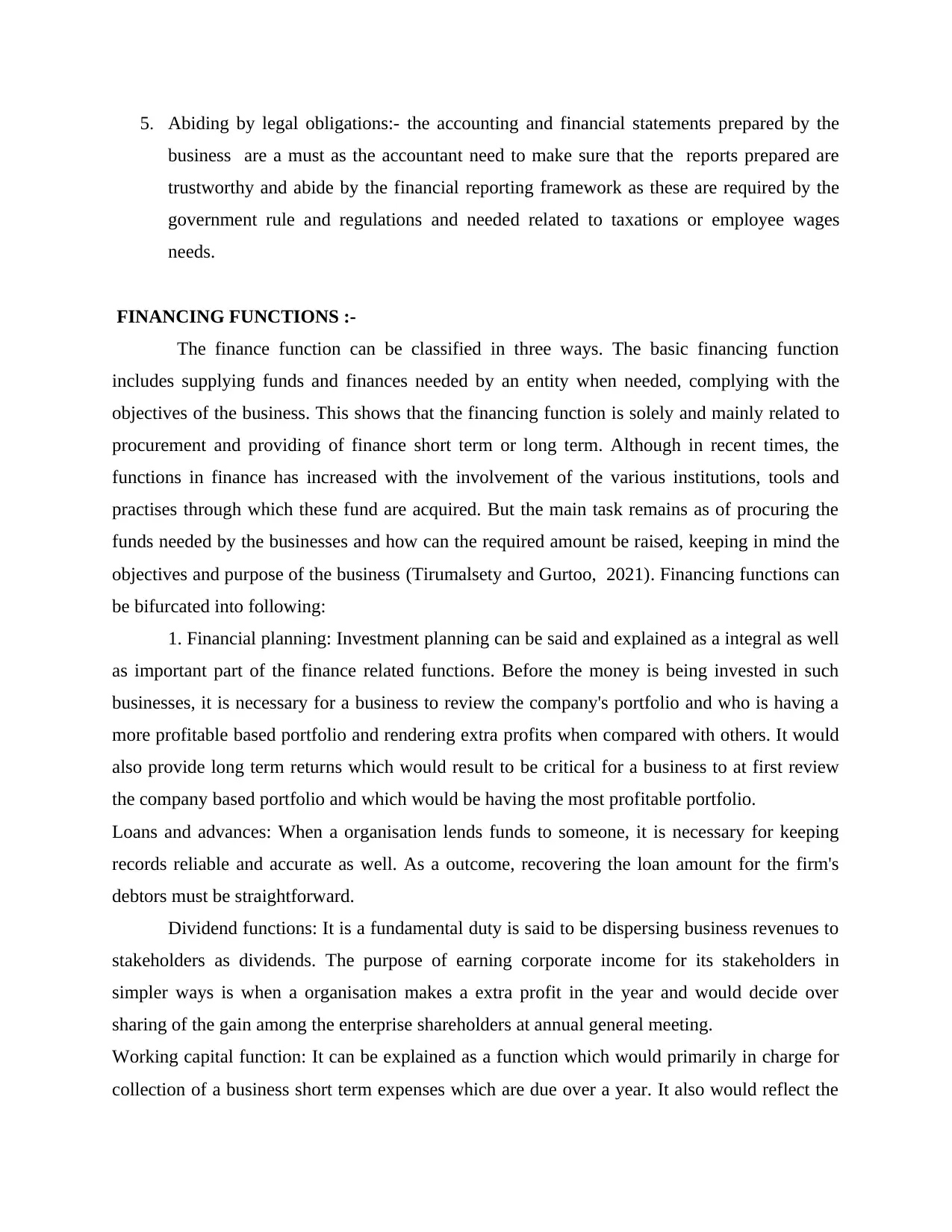
5. Abiding by legal obligations:- the accounting and financial statements prepared by the
business are a must as the accountant need to make sure that the reports prepared are
trustworthy and abide by the financial reporting framework as these are required by the
government rule and regulations and needed related to taxations or employee wages
needs.
FINANCING FUNCTIONS :-
The finance function can be classified in three ways. The basic financing function
includes supplying funds and finances needed by an entity when needed, complying with the
objectives of the business. This shows that the financing function is solely and mainly related to
procurement and providing of finance short term or long term. Although in recent times, the
functions in finance has increased with the involvement of the various institutions, tools and
practises through which these fund are acquired. But the main task remains as of procuring the
funds needed by the businesses and how can the required amount be raised, keeping in mind the
objectives and purpose of the business (Tirumalsety and Gurtoo, 2021). Financing functions can
be bifurcated into following:
1. Financial planning: Investment planning can be said and explained as a integral as well
as important part of the finance related functions. Before the money is being invested in such
businesses, it is necessary for a business to review the company's portfolio and who is having a
more profitable based portfolio and rendering extra profits when compared with others. It would
also provide long term returns which would result to be critical for a business to at first review
the company based portfolio and which would be having the most profitable portfolio.
Loans and advances: When a organisation lends funds to someone, it is necessary for keeping
records reliable and accurate as well. As a outcome, recovering the loan amount for the firm's
debtors must be straightforward.
Dividend functions: It is a fundamental duty is said to be dispersing business revenues to
stakeholders as dividends. The purpose of earning corporate income for its stakeholders in
simpler ways is when a organisation makes a extra profit in the year and would decide over
sharing of the gain among the enterprise shareholders at annual general meeting.
Working capital function: It can be explained as a function which would primarily in charge for
collection of a business short term expenses which are due over a year. It also would reflect the
business are a must as the accountant need to make sure that the reports prepared are
trustworthy and abide by the financial reporting framework as these are required by the
government rule and regulations and needed related to taxations or employee wages
needs.
FINANCING FUNCTIONS :-
The finance function can be classified in three ways. The basic financing function
includes supplying funds and finances needed by an entity when needed, complying with the
objectives of the business. This shows that the financing function is solely and mainly related to
procurement and providing of finance short term or long term. Although in recent times, the
functions in finance has increased with the involvement of the various institutions, tools and
practises through which these fund are acquired. But the main task remains as of procuring the
funds needed by the businesses and how can the required amount be raised, keeping in mind the
objectives and purpose of the business (Tirumalsety and Gurtoo, 2021). Financing functions can
be bifurcated into following:
1. Financial planning: Investment planning can be said and explained as a integral as well
as important part of the finance related functions. Before the money is being invested in such
businesses, it is necessary for a business to review the company's portfolio and who is having a
more profitable based portfolio and rendering extra profits when compared with others. It would
also provide long term returns which would result to be critical for a business to at first review
the company based portfolio and which would be having the most profitable portfolio.
Loans and advances: When a organisation lends funds to someone, it is necessary for keeping
records reliable and accurate as well. As a outcome, recovering the loan amount for the firm's
debtors must be straightforward.
Dividend functions: It is a fundamental duty is said to be dispersing business revenues to
stakeholders as dividends. The purpose of earning corporate income for its stakeholders in
simpler ways is when a organisation makes a extra profit in the year and would decide over
sharing of the gain among the enterprise shareholders at annual general meeting.
Working capital function: It can be explained as a function which would primarily in charge for
collection of a business short term expenses which are due over a year. It also would reflect the
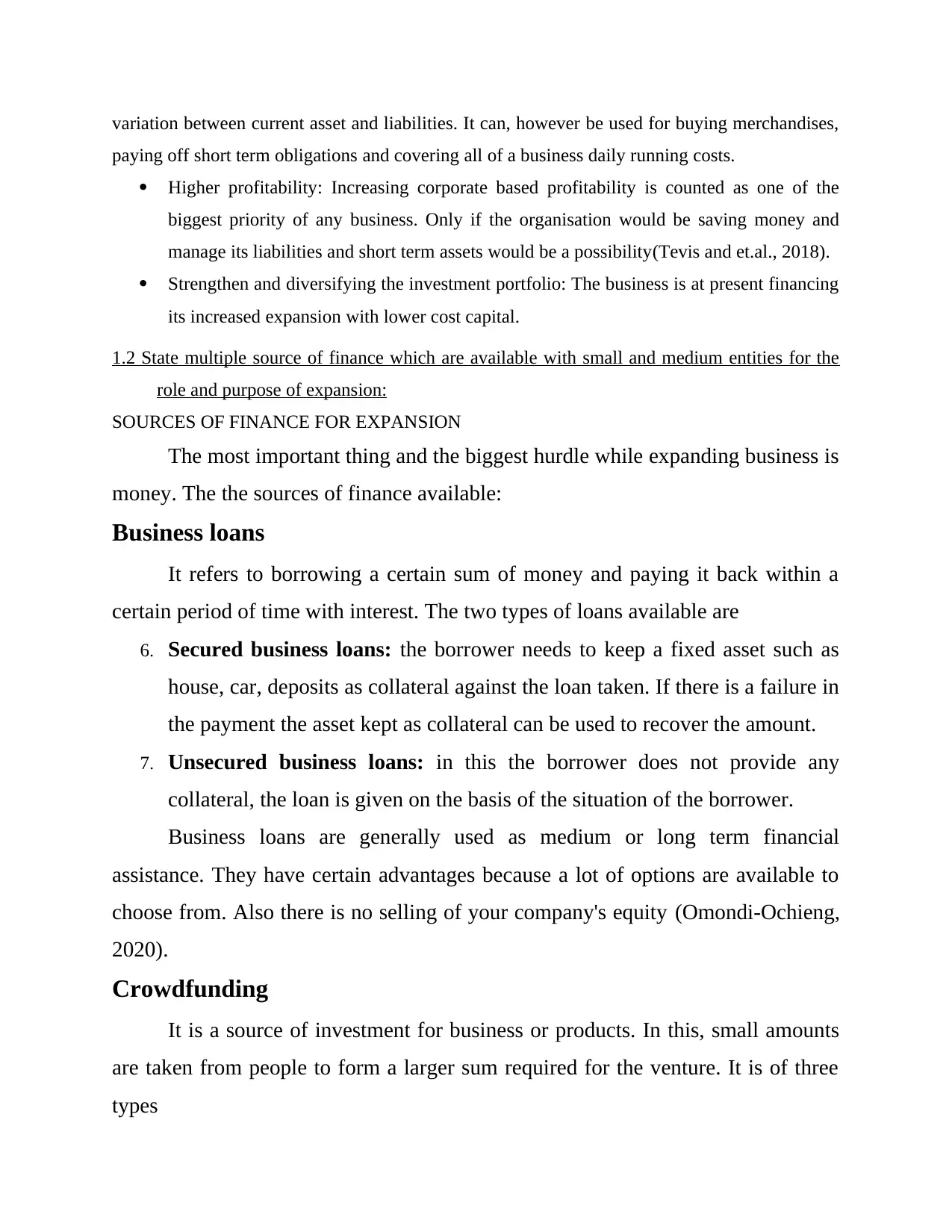
variation between current asset and liabilities. It can, however be used for buying merchandises,
paying off short term obligations and covering all of a business daily running costs.
Higher profitability: Increasing corporate based profitability is counted as one of the
biggest priority of any business. Only if the organisation would be saving money and
manage its liabilities and short term assets would be a possibility(Tevis and et.al., 2018).
Strengthen and diversifying the investment portfolio: The business is at present financing
its increased expansion with lower cost capital.
1.2 State multiple source of finance which are available with small and medium entities for the
role and purpose of expansion:
SOURCES OF FINANCE FOR EXPANSION
The most important thing and the biggest hurdle while expanding business is
money. The the sources of finance available:
Business loans
It refers to borrowing a certain sum of money and paying it back within a
certain period of time with interest. The two types of loans available are
6. Secured business loans: the borrower needs to keep a fixed asset such as
house, car, deposits as collateral against the loan taken. If there is a failure in
the payment the asset kept as collateral can be used to recover the amount.
7. Unsecured business loans: in this the borrower does not provide any
collateral, the loan is given on the basis of the situation of the borrower.
Business loans are generally used as medium or long term financial
assistance. They have certain advantages because a lot of options are available to
choose from. Also there is no selling of your company's equity (Omondi-Ochieng,
2020).
Crowdfunding
It is a source of investment for business or products. In this, small amounts
are taken from people to form a larger sum required for the venture. It is of three
types
paying off short term obligations and covering all of a business daily running costs.
Higher profitability: Increasing corporate based profitability is counted as one of the
biggest priority of any business. Only if the organisation would be saving money and
manage its liabilities and short term assets would be a possibility(Tevis and et.al., 2018).
Strengthen and diversifying the investment portfolio: The business is at present financing
its increased expansion with lower cost capital.
1.2 State multiple source of finance which are available with small and medium entities for the
role and purpose of expansion:
SOURCES OF FINANCE FOR EXPANSION
The most important thing and the biggest hurdle while expanding business is
money. The the sources of finance available:
Business loans
It refers to borrowing a certain sum of money and paying it back within a
certain period of time with interest. The two types of loans available are
6. Secured business loans: the borrower needs to keep a fixed asset such as
house, car, deposits as collateral against the loan taken. If there is a failure in
the payment the asset kept as collateral can be used to recover the amount.
7. Unsecured business loans: in this the borrower does not provide any
collateral, the loan is given on the basis of the situation of the borrower.
Business loans are generally used as medium or long term financial
assistance. They have certain advantages because a lot of options are available to
choose from. Also there is no selling of your company's equity (Omondi-Ochieng,
2020).
Crowdfunding
It is a source of investment for business or products. In this, small amounts
are taken from people to form a larger sum required for the venture. It is of three
types
⊘ This is a preview!⊘
Do you want full access?
Subscribe today to unlock all pages.

Trusted by 1+ million students worldwide
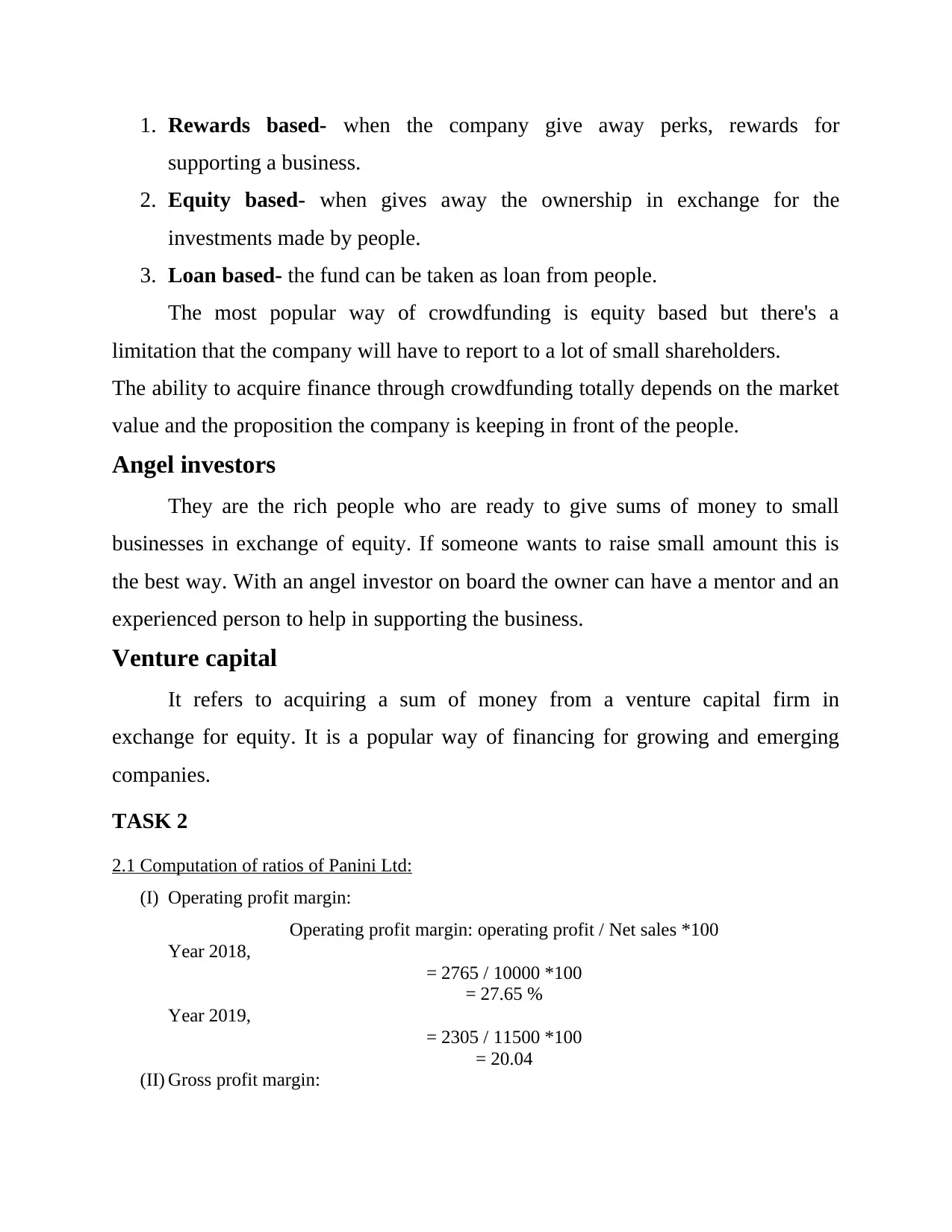
1. Rewards based- when the company give away perks, rewards for
supporting a business.
2. Equity based- when gives away the ownership in exchange for the
investments made by people.
3. Loan based- the fund can be taken as loan from people.
The most popular way of crowdfunding is equity based but there's a
limitation that the company will have to report to a lot of small shareholders.
The ability to acquire finance through crowdfunding totally depends on the market
value and the proposition the company is keeping in front of the people.
Angel investors
They are the rich people who are ready to give sums of money to small
businesses in exchange of equity. If someone wants to raise small amount this is
the best way. With an angel investor on board the owner can have a mentor and an
experienced person to help in supporting the business.
Venture capital
It refers to acquiring a sum of money from a venture capital firm in
exchange for equity. It is a popular way of financing for growing and emerging
companies.
TASK 2
2.1 Computation of ratios of Panini Ltd:
(I) Operating profit margin:
Operating profit margin: operating profit / Net sales *100
Year 2018,
= 2765 / 10000 *100
= 27.65 %
Year 2019,
= 2305 / 11500 *100
= 20.04
(II) Gross profit margin:
supporting a business.
2. Equity based- when gives away the ownership in exchange for the
investments made by people.
3. Loan based- the fund can be taken as loan from people.
The most popular way of crowdfunding is equity based but there's a
limitation that the company will have to report to a lot of small shareholders.
The ability to acquire finance through crowdfunding totally depends on the market
value and the proposition the company is keeping in front of the people.
Angel investors
They are the rich people who are ready to give sums of money to small
businesses in exchange of equity. If someone wants to raise small amount this is
the best way. With an angel investor on board the owner can have a mentor and an
experienced person to help in supporting the business.
Venture capital
It refers to acquiring a sum of money from a venture capital firm in
exchange for equity. It is a popular way of financing for growing and emerging
companies.
TASK 2
2.1 Computation of ratios of Panini Ltd:
(I) Operating profit margin:
Operating profit margin: operating profit / Net sales *100
Year 2018,
= 2765 / 10000 *100
= 27.65 %
Year 2019,
= 2305 / 11500 *100
= 20.04
(II) Gross profit margin:
Paraphrase This Document
Need a fresh take? Get an instant paraphrase of this document with our AI Paraphraser
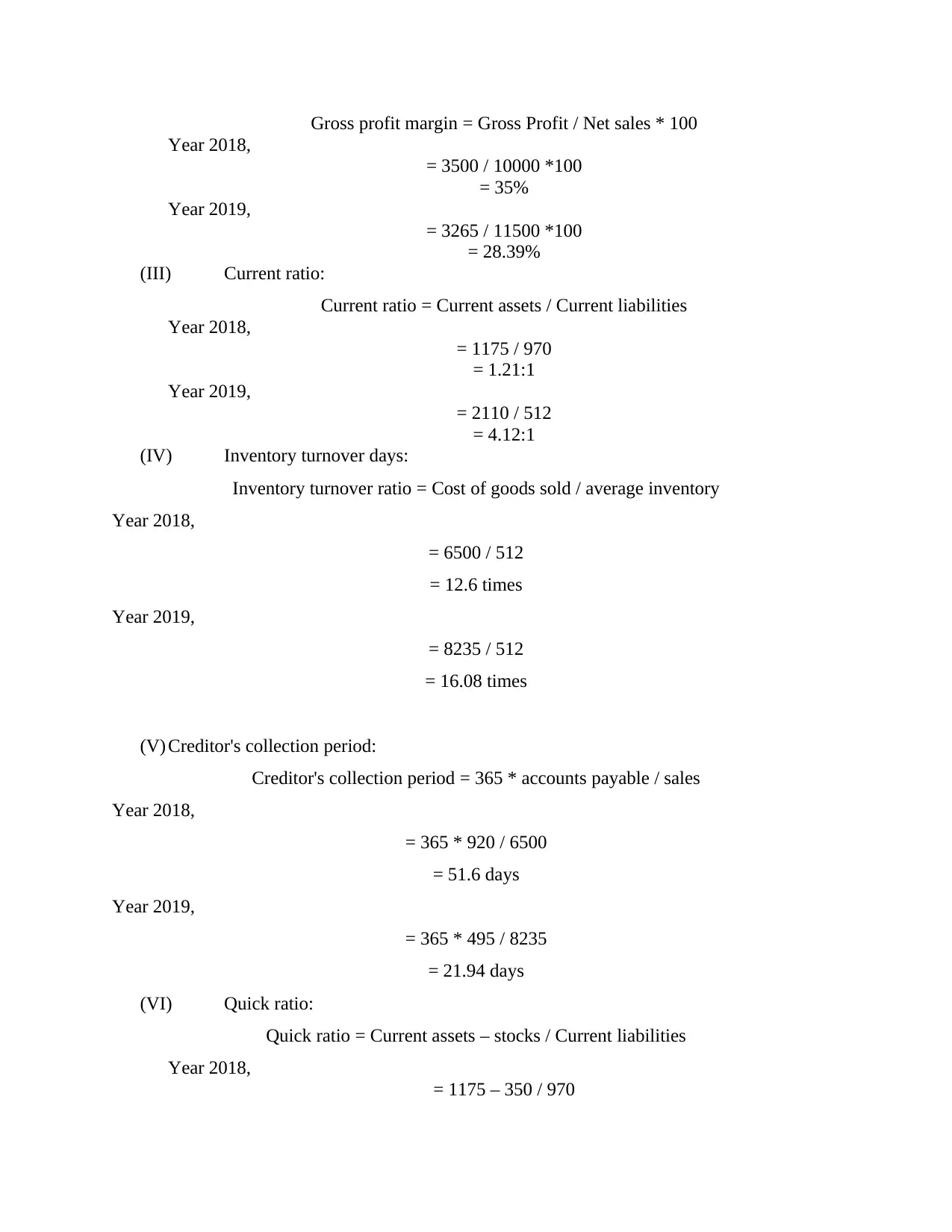
Gross profit margin = Gross Profit / Net sales * 100
Year 2018,
= 3500 / 10000 *100
= 35%
Year 2019,
= 3265 / 11500 *100
= 28.39%
(III) Current ratio:
Current ratio = Current assets / Current liabilities
Year 2018,
= 1175 / 970
= 1.21:1
Year 2019,
= 2110 / 512
= 4.12:1
(IV) Inventory turnover days:
Inventory turnover ratio = Cost of goods sold / average inventory
Year 2018,
= 6500 / 512
= 12.6 times
Year 2019,
= 8235 / 512
= 16.08 times
(V) Creditor's collection period:
Creditor's collection period = 365 * accounts payable / sales
Year 2018,
= 365 * 920 / 6500
= 51.6 days
Year 2019,
= 365 * 495 / 8235
= 21.94 days
(VI) Quick ratio:
Quick ratio = Current assets – stocks / Current liabilities
Year 2018,
= 1175 – 350 / 970
Year 2018,
= 3500 / 10000 *100
= 35%
Year 2019,
= 3265 / 11500 *100
= 28.39%
(III) Current ratio:
Current ratio = Current assets / Current liabilities
Year 2018,
= 1175 / 970
= 1.21:1
Year 2019,
= 2110 / 512
= 4.12:1
(IV) Inventory turnover days:
Inventory turnover ratio = Cost of goods sold / average inventory
Year 2018,
= 6500 / 512
= 12.6 times
Year 2019,
= 8235 / 512
= 16.08 times
(V) Creditor's collection period:
Creditor's collection period = 365 * accounts payable / sales
Year 2018,
= 365 * 920 / 6500
= 51.6 days
Year 2019,
= 365 * 495 / 8235
= 21.94 days
(VI) Quick ratio:
Quick ratio = Current assets – stocks / Current liabilities
Year 2018,
= 1175 – 350 / 970
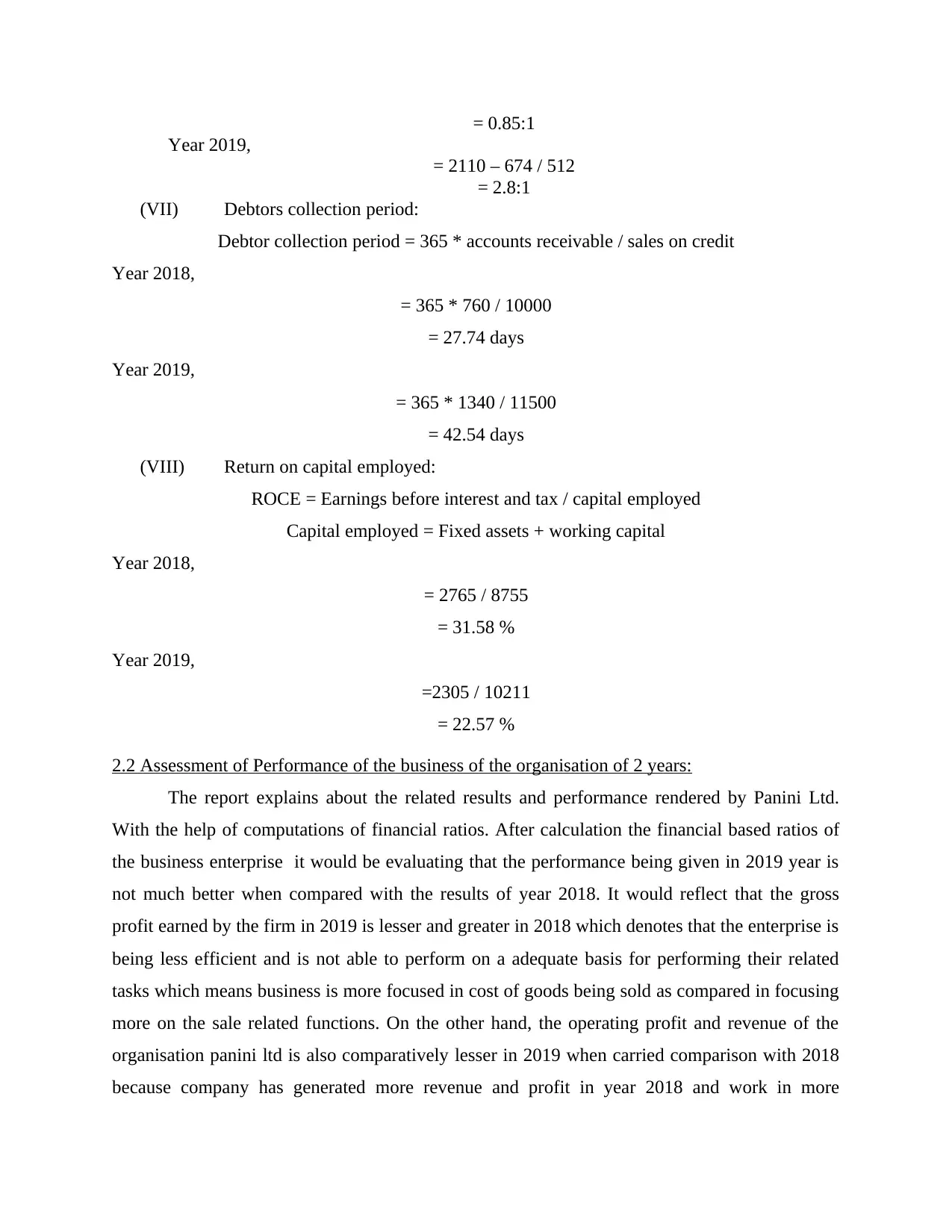
= 0.85:1
Year 2019,
= 2110 – 674 / 512
= 2.8:1
(VII) Debtors collection period:
Debtor collection period = 365 * accounts receivable / sales on credit
Year 2018,
= 365 * 760 / 10000
= 27.74 days
Year 2019,
= 365 * 1340 / 11500
= 42.54 days
(VIII) Return on capital employed:
ROCE = Earnings before interest and tax / capital employed
Capital employed = Fixed assets + working capital
Year 2018,
= 2765 / 8755
= 31.58 %
Year 2019,
=2305 / 10211
= 22.57 %
2.2 Assessment of Performance of the business of the organisation of 2 years:
The report explains about the related results and performance rendered by Panini Ltd.
With the help of computations of financial ratios. After calculation the financial based ratios of
the business enterprise it would be evaluating that the performance being given in 2019 year is
not much better when compared with the results of year 2018. It would reflect that the gross
profit earned by the firm in 2019 is lesser and greater in 2018 which denotes that the enterprise is
being less efficient and is not able to perform on a adequate basis for performing their related
tasks which means business is more focused in cost of goods being sold as compared in focusing
more on the sale related functions. On the other hand, the operating profit and revenue of the
organisation panini ltd is also comparatively lesser in 2019 when carried comparison with 2018
because company has generated more revenue and profit in year 2018 and work in more
Year 2019,
= 2110 – 674 / 512
= 2.8:1
(VII) Debtors collection period:
Debtor collection period = 365 * accounts receivable / sales on credit
Year 2018,
= 365 * 760 / 10000
= 27.74 days
Year 2019,
= 365 * 1340 / 11500
= 42.54 days
(VIII) Return on capital employed:
ROCE = Earnings before interest and tax / capital employed
Capital employed = Fixed assets + working capital
Year 2018,
= 2765 / 8755
= 31.58 %
Year 2019,
=2305 / 10211
= 22.57 %
2.2 Assessment of Performance of the business of the organisation of 2 years:
The report explains about the related results and performance rendered by Panini Ltd.
With the help of computations of financial ratios. After calculation the financial based ratios of
the business enterprise it would be evaluating that the performance being given in 2019 year is
not much better when compared with the results of year 2018. It would reflect that the gross
profit earned by the firm in 2019 is lesser and greater in 2018 which denotes that the enterprise is
being less efficient and is not able to perform on a adequate basis for performing their related
tasks which means business is more focused in cost of goods being sold as compared in focusing
more on the sale related functions. On the other hand, the operating profit and revenue of the
organisation panini ltd is also comparatively lesser in 2019 when carried comparison with 2018
because company has generated more revenue and profit in year 2018 and work in more
⊘ This is a preview!⊘
Do you want full access?
Subscribe today to unlock all pages.

Trusted by 1+ million students worldwide
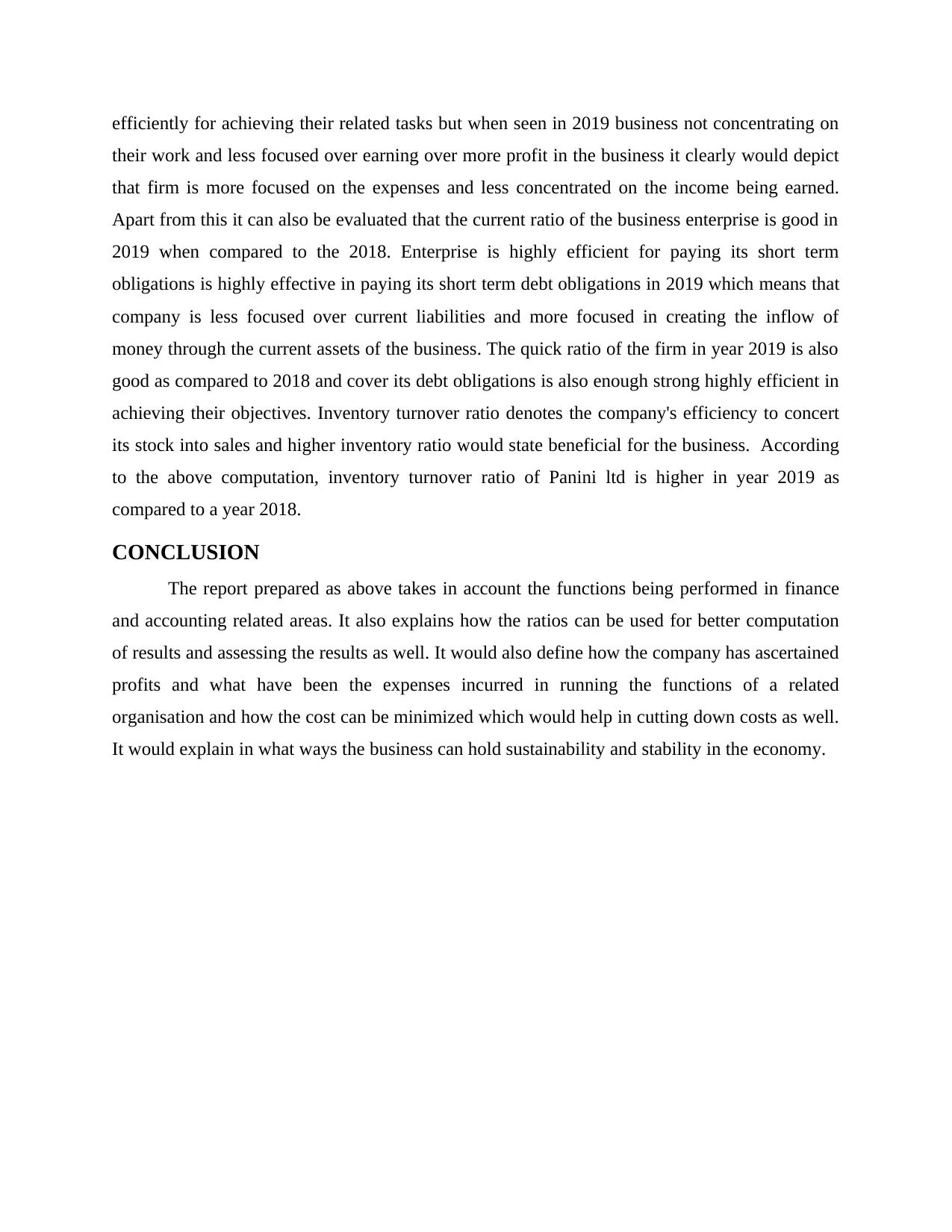
efficiently for achieving their related tasks but when seen in 2019 business not concentrating on
their work and less focused over earning over more profit in the business it clearly would depict
that firm is more focused on the expenses and less concentrated on the income being earned.
Apart from this it can also be evaluated that the current ratio of the business enterprise is good in
2019 when compared to the 2018. Enterprise is highly efficient for paying its short term
obligations is highly effective in paying its short term debt obligations in 2019 which means that
company is less focused over current liabilities and more focused in creating the inflow of
money through the current assets of the business. The quick ratio of the firm in year 2019 is also
good as compared to 2018 and cover its debt obligations is also enough strong highly efficient in
achieving their objectives. Inventory turnover ratio denotes the company's efficiency to concert
its stock into sales and higher inventory ratio would state beneficial for the business. According
to the above computation, inventory turnover ratio of Panini ltd is higher in year 2019 as
compared to a year 2018.
CONCLUSION
The report prepared as above takes in account the functions being performed in finance
and accounting related areas. It also explains how the ratios can be used for better computation
of results and assessing the results as well. It would also define how the company has ascertained
profits and what have been the expenses incurred in running the functions of a related
organisation and how the cost can be minimized which would help in cutting down costs as well.
It would explain in what ways the business can hold sustainability and stability in the economy.
their work and less focused over earning over more profit in the business it clearly would depict
that firm is more focused on the expenses and less concentrated on the income being earned.
Apart from this it can also be evaluated that the current ratio of the business enterprise is good in
2019 when compared to the 2018. Enterprise is highly efficient for paying its short term
obligations is highly effective in paying its short term debt obligations in 2019 which means that
company is less focused over current liabilities and more focused in creating the inflow of
money through the current assets of the business. The quick ratio of the firm in year 2019 is also
good as compared to 2018 and cover its debt obligations is also enough strong highly efficient in
achieving their objectives. Inventory turnover ratio denotes the company's efficiency to concert
its stock into sales and higher inventory ratio would state beneficial for the business. According
to the above computation, inventory turnover ratio of Panini ltd is higher in year 2019 as
compared to a year 2018.
CONCLUSION
The report prepared as above takes in account the functions being performed in finance
and accounting related areas. It also explains how the ratios can be used for better computation
of results and assessing the results as well. It would also define how the company has ascertained
profits and what have been the expenses incurred in running the functions of a related
organisation and how the cost can be minimized which would help in cutting down costs as well.
It would explain in what ways the business can hold sustainability and stability in the economy.
Paraphrase This Document
Need a fresh take? Get an instant paraphrase of this document with our AI Paraphraser
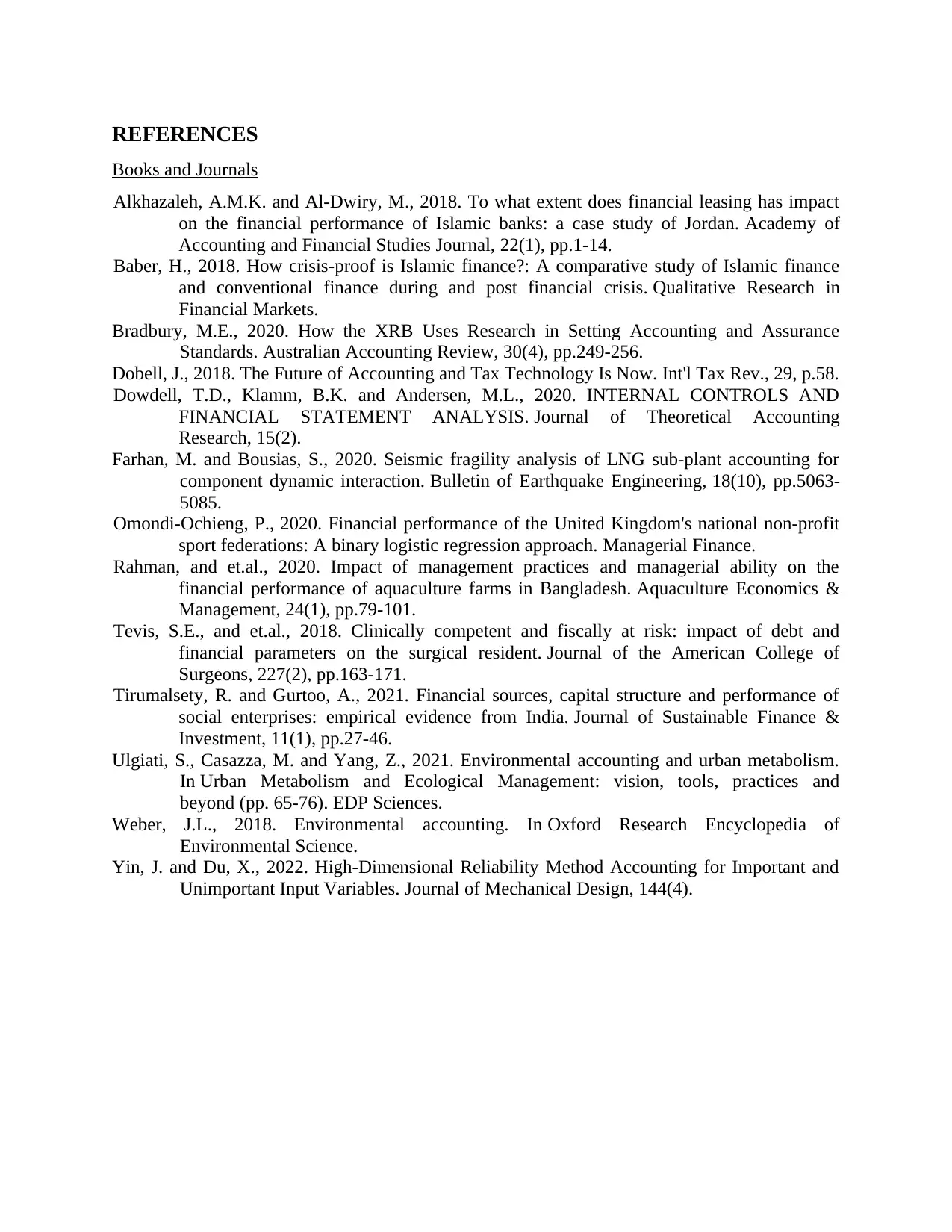
REFERENCES
Books and Journals
Alkhazaleh, A.M.K. and Al-Dwiry, M., 2018. To what extent does financial leasing has impact
on the financial performance of Islamic banks: a case study of Jordan. Academy of
Accounting and Financial Studies Journal, 22(1), pp.1-14.
Baber, H., 2018. How crisis-proof is Islamic finance?: A comparative study of Islamic finance
and conventional finance during and post financial crisis. Qualitative Research in
Financial Markets.
Bradbury, M.E., 2020. How the XRB Uses Research in Setting Accounting and Assurance
Standards. Australian Accounting Review, 30(4), pp.249-256.
Dobell, J., 2018. The Future of Accounting and Tax Technology Is Now. Int'l Tax Rev., 29, p.58.
Dowdell, T.D., Klamm, B.K. and Andersen, M.L., 2020. INTERNAL CONTROLS AND
FINANCIAL STATEMENT ANALYSIS. Journal of Theoretical Accounting
Research, 15(2).
Farhan, M. and Bousias, S., 2020. Seismic fragility analysis of LNG sub-plant accounting for
component dynamic interaction. Bulletin of Earthquake Engineering, 18(10), pp.5063-
5085.
Omondi-Ochieng, P., 2020. Financial performance of the United Kingdom's national non-profit
sport federations: A binary logistic regression approach. Managerial Finance.
Rahman, and et.al., 2020. Impact of management practices and managerial ability on the
financial performance of aquaculture farms in Bangladesh. Aquaculture Economics &
Management, 24(1), pp.79-101.
Tevis, S.E., and et.al., 2018. Clinically competent and fiscally at risk: impact of debt and
financial parameters on the surgical resident. Journal of the American College of
Surgeons, 227(2), pp.163-171.
Tirumalsety, R. and Gurtoo, A., 2021. Financial sources, capital structure and performance of
social enterprises: empirical evidence from India. Journal of Sustainable Finance &
Investment, 11(1), pp.27-46.
Ulgiati, S., Casazza, M. and Yang, Z., 2021. Environmental accounting and urban metabolism.
In Urban Metabolism and Ecological Management: vision, tools, practices and
beyond (pp. 65-76). EDP Sciences.
Weber, J.L., 2018. Environmental accounting. In Oxford Research Encyclopedia of
Environmental Science.
Yin, J. and Du, X., 2022. High-Dimensional Reliability Method Accounting for Important and
Unimportant Input Variables. Journal of Mechanical Design, 144(4).
Books and Journals
Alkhazaleh, A.M.K. and Al-Dwiry, M., 2018. To what extent does financial leasing has impact
on the financial performance of Islamic banks: a case study of Jordan. Academy of
Accounting and Financial Studies Journal, 22(1), pp.1-14.
Baber, H., 2018. How crisis-proof is Islamic finance?: A comparative study of Islamic finance
and conventional finance during and post financial crisis. Qualitative Research in
Financial Markets.
Bradbury, M.E., 2020. How the XRB Uses Research in Setting Accounting and Assurance
Standards. Australian Accounting Review, 30(4), pp.249-256.
Dobell, J., 2018. The Future of Accounting and Tax Technology Is Now. Int'l Tax Rev., 29, p.58.
Dowdell, T.D., Klamm, B.K. and Andersen, M.L., 2020. INTERNAL CONTROLS AND
FINANCIAL STATEMENT ANALYSIS. Journal of Theoretical Accounting
Research, 15(2).
Farhan, M. and Bousias, S., 2020. Seismic fragility analysis of LNG sub-plant accounting for
component dynamic interaction. Bulletin of Earthquake Engineering, 18(10), pp.5063-
5085.
Omondi-Ochieng, P., 2020. Financial performance of the United Kingdom's national non-profit
sport federations: A binary logistic regression approach. Managerial Finance.
Rahman, and et.al., 2020. Impact of management practices and managerial ability on the
financial performance of aquaculture farms in Bangladesh. Aquaculture Economics &
Management, 24(1), pp.79-101.
Tevis, S.E., and et.al., 2018. Clinically competent and fiscally at risk: impact of debt and
financial parameters on the surgical resident. Journal of the American College of
Surgeons, 227(2), pp.163-171.
Tirumalsety, R. and Gurtoo, A., 2021. Financial sources, capital structure and performance of
social enterprises: empirical evidence from India. Journal of Sustainable Finance &
Investment, 11(1), pp.27-46.
Ulgiati, S., Casazza, M. and Yang, Z., 2021. Environmental accounting and urban metabolism.
In Urban Metabolism and Ecological Management: vision, tools, practices and
beyond (pp. 65-76). EDP Sciences.
Weber, J.L., 2018. Environmental accounting. In Oxford Research Encyclopedia of
Environmental Science.
Yin, J. and Du, X., 2022. High-Dimensional Reliability Method Accounting for Important and
Unimportant Input Variables. Journal of Mechanical Design, 144(4).

⊘ This is a preview!⊘
Do you want full access?
Subscribe today to unlock all pages.

Trusted by 1+ million students worldwide
1 out of 12
Related Documents
Your All-in-One AI-Powered Toolkit for Academic Success.
+13062052269
info@desklib.com
Available 24*7 on WhatsApp / Email
![[object Object]](/_next/static/media/star-bottom.7253800d.svg)
Unlock your academic potential
Copyright © 2020–2025 A2Z Services. All Rights Reserved. Developed and managed by ZUCOL.


